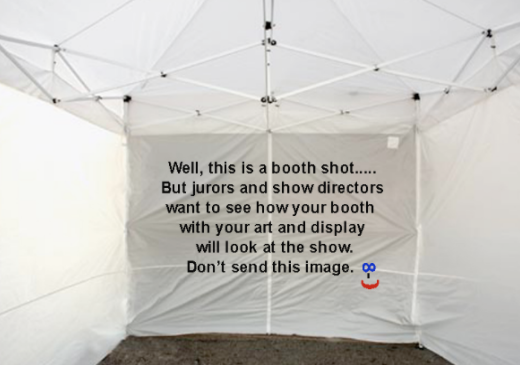In preparation for a session at the 2015 Arts Festival Conference, artist and show director Carla Fox (Art in the High Desert – Bend, OR) and artist David Bjurstrom surveyed the field to learn the general consensus about what makes for a strong booth photo. Pairing together their many years of experience in the art fair industry with these survey findings, Fox and Bjurstrom created recommendations for preparing the best booth photo.
As we’re coming upon festival season, we know many artists will have the opportunity to take new booth photos. If you think yours could use some work, keep reading for guidance on how to improve your photo — and maybe even your chances at getting invited to shows!
The Importance of Booth Images
Booth images matter more than you may think. Jurors probably comment and react negatively to booth images more than anything else in the jury room. For many artists, booth images are the Achilles heel of their applications. The booth image is the last image that the jurors see, and thus, your last impression. As an artist, your booth image should convey to jurors that you are a professional at the top of your game. It’s in your best interest to give them a strong, accurate booth image to help them make their decisions.
Above all else, you want the jury to glance at your booth shot, understand it immediately, and then return to the images you submitted on the application. If anything in your booth photo distracts a juror or raises a question, you may have lost your chance of being invited to a show.
Many jurors will tell you that often the difference between getting into a show and being placed on the waitlist or, worse, not being invited, lies in a mediocre booth photo that causes your score to be lower than another artist whose work may be equal, but who has a better booth shot.
Booth Image Considerations
- Names and identifying information on booth images. In a blind jury, it is expected that artists remove, blur, or mask their names before submitting booth images. Having a name clearly seen in the booth, image title, or in an artist statement is not in the artist’s favor. For 2-D artists —especially painters — consider blurring your signature if it is easy to read on your work.
- Ribbons and awards. The jury does not want to see that you won ribbons and awards at a past show. It will not impact their decision.
- Booth images with work different from the images on the application. This confuses jurors and can make them question the artist’s intention. A common concern is that the artist may attempt to bring work that has not been juried in if the artist is invited to participate.
- Booth distractions. Avoid anything that restricts jurors from seeing the artwork. Do not submit booth photos that have patrons, other artists or yourself in the shot. Poorly lit or out of focus images can also be distracting.
- Messy, unprofessional booths. Put your best foot forward by displaying a clean booth. Remove trash, food, clothing, and other items that are not a part of your booth before taking the photo. If you use browse bins, consider taking some booth photos with and some without.
- Using Photoshop or photo imaging software. Booths that look unreal are a major turn-off to jurors. Jurors want to see how your booth will look at the show and a highly photoshopped image can cause jurors to focus on why the image was created in Photoshop (or so heavily edited) rather than your art.
- Supplying a non-booth shot as your booth photo. Sometimes this is the only option, especially for those new to the business. If you don’t have some type of booth shot, explain why you don’t in your application. You should also indicate that you are a new or emerging artist without a booth photo in the photo title.
- Partial booth photos. If the booth image shows only part of the booth, the jury may wonder what is missing from the image or if there is something there that the artist doesn’t want them to see. It’s best to capture a photo that includes all three walls of your booth.
- Crop your photo. Keep your booth as the focal point by cropping your booth photos so that you show only your canopy/tent with your work inside.
- Highlight your artwork. Your art should be the star of your booth. Many jurors find wildly graphic floor coverings or curtains in the booth image to be a distraction.
Analysis and Recommendations: What Does this all Mean?
At every show you attend, you have the opportunity to take a new and great photo! On the first day of the show, watch the ebb and flow of the crowd and how the light hits your booth. Pick a time when your booth is well lit and crowds are down. Early morning or late afternoon works well, but avoid shooting the image directly into the sun. To aid in taking a professional caliber photo, consider using a tripod and shoot from a variety of angles. If you’ve got different display set-ups for your work, be sure to capture photos for each set-up type.
Finally — remember that a booth shot is an integral part of your application to most juried shows. Keep your booth photo professional-looking and ensure it’s an accurate representation of how your booth will look at the show. Many shows using ZAPP will require a booth photo, and using the tips above can help you to improve your photo so the jury spends more time looking at your artwork and not questioning your display.


